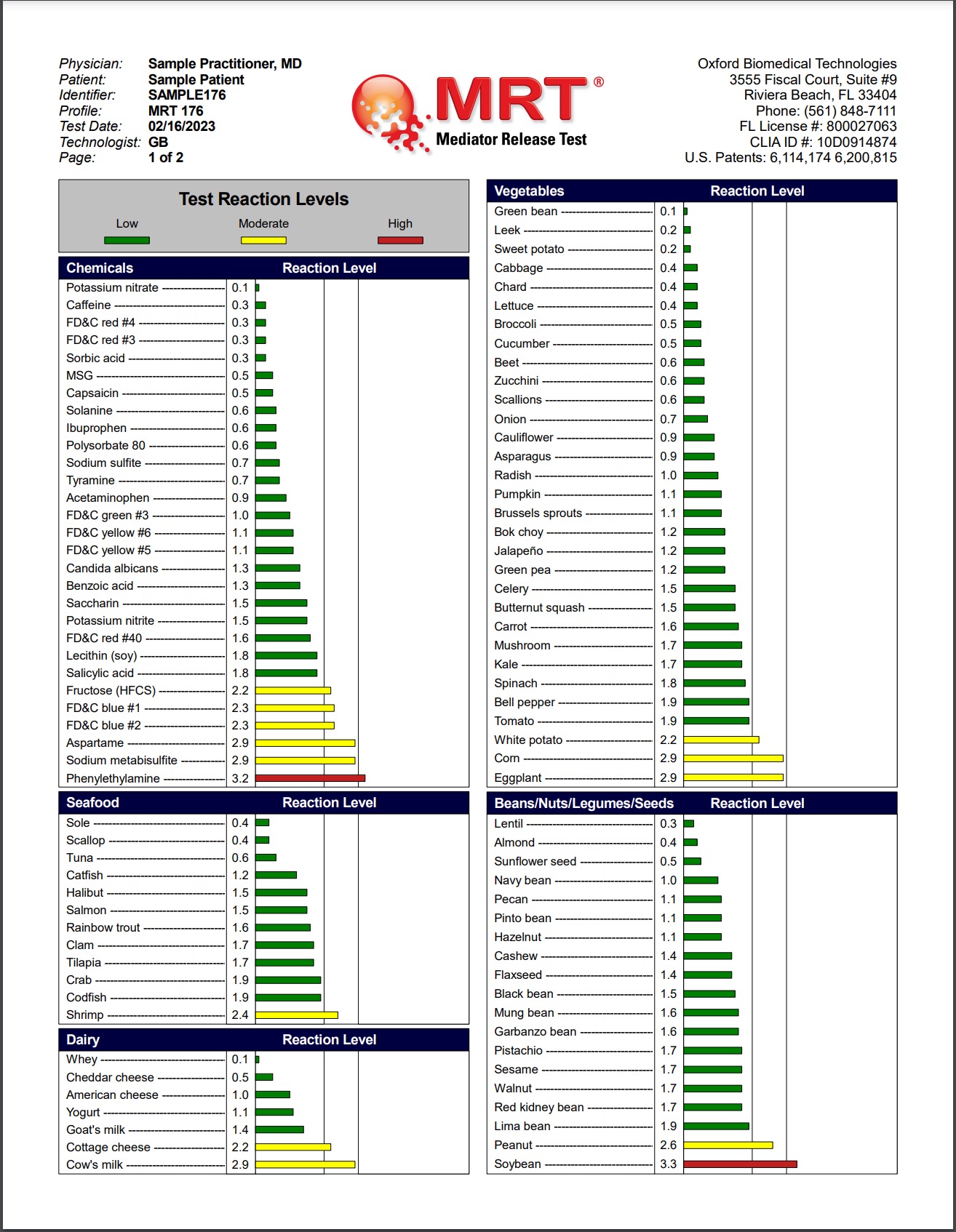
How is MRT different from other food sensitivity tests?
Is something you’re eating causing or worsening your symptoms? If so, you may be suffering from food sensitivities. Determining which foods are triggering your symptoms can feel like an endless hamster wheel.
There are a lot of food sensitivity tests on the market these days that bombard us with advertisements and hopeful claims. But, are these tests legitimate? How can you know which food sensitivity test is best?
In this article, we’ll review food sensitivities and how the Mediator Release Test (MRT) is different from all other food sensitivity panels.
What are Food Sensitivities?
Food sensitivities occur when your immune system reacts to a particular food.
However, unlike food allergies, food sensitivity reactions are often delayed and dose-dependent (1). This means that a food you ate yesterday could cause unwanted symptoms today or even tomorrow!
Food allergies only use one pathway of the immune system. But, food sensitivities can go through two different pathways in your body to cause symptoms (2). These are known as type III and type IV reactions and involve antibodies (like IgG, IgA, or IgM) or white blood cells.
The end result of ALL food sensitivity reactions is the release of immune chemicals called mediators from your white blood cells. It’s the release of meditators that end up causing your unwanted symptoms of food sensitivities.
Common symptoms of food sensitivities include:
- Abdominal pain or bloating
- Constipation or diarrhea
- Acid reflux
- Migraines
- Acne or eczema
- Chronic fatigue
- Depression
- Brain fog
- Flare of autoimmune symptoms
- Joint pains
Each person has an individualized response to food sensitivity reactions, so the list of potential symptoms is often quite long. If you suspect that a certain food may be causing or worsening your symptoms, you may want to consider food sensitivity testing.
What is the Mediator Release Test (MRT)?
The MRT panel is the food sensitivity test that we use with our members at Root.
It is a blood test that analyzes your individual response to 176 different foods and chemicals.
We send your blood sample to Oxford Labs, who then use a machine to expose your blood cells to each freeze-dried food or chemical antigen.
The machine determines your individualized response by measuring the size of your white blood cells before and after exposure to each tested item. The more your white blood cells shrink, the more pro-inflammatory chemicals they have released, and thus the stronger your food sensitivity reaction.
MRT is measuring your body’s reaction to foods down to what is actually happening to your cells when they are exposed to the foods or chemicals.
You can see the magnitude of your individual response to each food or chemical, as indicated by a bar graph on your MRT results.
How is MRT Different?
There are a lot of food sensitivity tests on the market. But ultimately, the MRT panel is the best option for testing food sensitivities for a few reasons.
First of all, MRT captures ALL types of food sensitivity reactions (type III and IV) by indirectly measuring the release of inflammatory chemicals called mediators. It’s the release of mediators that cause symptoms of food sensitivities.
Most other food sensitivity tests only look at one potential pathway of food sensitivities, known as IgG antibodies. If we only look at this one pathway, then we don’t get the full picture. Additionally, IgG antibodies may increase as a normal result of eating certain foods. So, a positive result on an IgG food sensitivity test may simply indicate that you have recently eaten that food - not that you necessarily have a negative reaction to it!
However, the biggest factor that distinguishes MRT from other food sensitivity tests is the essential elimination diet protocol that goes with it, called LEAP.

MRT + LEAP Elimination Diet
We use the MRT panel with an elimination diet protocol, called LEAP (Lifestyle Eating and Performance).
Treating food sensitivities is more than just avoiding your red and yellow (reactive) foods. Our dietitians work with you to develop a personalized food sensitivity elimination diet based on your MRT results and functional nutrition assessment.
The diet protocol is broken into phases over a 2 to 3 month period. For the first two weeks, you will eat roughly 30 of your lowest reactive “green” foods.
In this time, many people experience a 50 to 75% reduction in their symptom frequency and/or severity.
Once you begin feeling better, we slowly add one food into your diet at a time, monitor for any reactions that may occur, and set you up for long term success.
MRT is a Personalized Tool For Healing
Functional medicine uses individualized protocols based on your unique symptoms, immune system, genetics, and more.
Functional lab testing, like the MRT food sensitivity panel, is an essential tool in our practice to personalize your care and help you find symptom relief and healing.
Due to high demand, we currently only offer the MRT test to members of our functional medicine program.

Get to the Root at Home
Curious about where you should start your functional medicine journey?
Take our Get to the Root Quiz so you can start working towards reversing disease and optimizing your health at the Root cause.
Take the Get to the Root Quiz
Related Articles

Gut Health and Hormones
The gut plays a crucial role in maintaining hormonal balance in the body. Gut health can influence hormones such as estrogen, thyroid, insulin, and serotonin.

Ashwagandha for PCOS
Ashwagandha is an adaptogen that helps the body respond to stress and supports normal hormone production. It may help women with PCOS by balancing cortisol levels, lowering blood sugar, reducing anxiety, and supporting thyroid health.